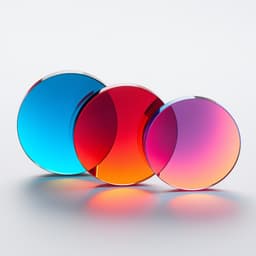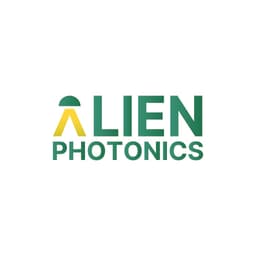


Dichroic Mirrors (Wavelength & Harmonic Separators and Combiners)
Dichroic Mirror separates light beam into two beams, by reflecting specific wavelengths and letting other wavelengths to pass through. Alien Photonics Dichroic Mirrors can be used to both separate or combine wavelengths. Optimization for reflection or transmission, various materials, shapes, LIDT options available.
Estimated Shipping Date: January 5, 2026 - January 19, 2026
* - Shopping cart pricing is based on the most recent pricing and it is NOT ORDERING, but requesting an official quotation which should typically reach You within 1-2 business days.
- Description
- Characteristics
- Types
Dichroic Mirrors (Wavelength Separators): Functioning principle and advantages
What is the purpose (function) of a Dichroic Mirror?
Purpose (function) of dichroic mirror is to separate two wavelengths (or range of wavelenghts) by reflecting and transmitting them at the designed angles. This component can be used to separate harmonics of the same laser, or guide beam in with multi-laser systems.
How does Dichroic Mirror work?
Dichroic mirrors transmit specific wavelength (or range) and reflect another wavelength (or range) back or at the designed angle (AOI). Unlike dual-band mirrors (which reflect both wavelengths), dichroic mirrors are specifically designed to separate wavelengths (e.g. laser harmonics).
What are the advantages of Dichroic Mirrors?
Dichroic mirrors biggest advantage is minimal light loss when separating wavelengths and high precision in wavelength selection. These dichroics are designed to both reflect and transmitt light (unlike absorption-type color filters), so dielectric coated dichroic mirrors can be used in high energy lasers.
What is the difference between Dichroic Mirrors and Dichroic Filters?
Dichroic mirrors reflect and transmit wavelengths, while dichroic filters, typically transmit and absorb the light. Dichroic mirrors allow to minimize light loss and enables higher intensities, on the other hand dichroic filters are more economical dichroic component especially suitable for low power and imaging applications.
Typical characteristics of Dichroic Mirrors
Alien Photonics dichroic mirrors (wavelength separators) can be customized in the variety of aspects. Please, treat contents of this table as guidelines.
| Aspect | Details |
|---|---|
| Wavelength Range | UV (~180 nm) to IR (~15,000 nm) |
| Sizes | Few millimeters to a few hundred millimeters |
| Configurations | Short-pass, Long-pass, Harmonic separation, Custom wavelength separation, Combiner |
| Shapes | Round, Rectangular, Custom shapes |
| Surface Form | Flat (Plano, high/standard parallelism - UV-VIS-NIR or IR), Wedge, Curved |
| Substrate Materials | Standard UVFS and others |
| Laser Induced Damage Threshold (LIDT) | Low and High LIDT options |
| Angle of Incidence (AOI) | 45°, 0°, Custom angles (e.g., 15°, 22.5°, 30°, 56°), angle range (±5°, 22.5°-45°, 45°-55°) |
Different types of dichroic mirrors: Harmonic seprarators, wavelength separators, short-pass and long-pass dichroic mirrors
Harmonic Separators
Special type of wavelength separator, intentionally designed to separate harmonics of specific laser. Although not as universal as long pass or short pass dichroic mirrors, Alien Photonics harmonic separators can exhibit better transmission and reflection values, because these separators are usually designed specifcaly for 2 or three wavelengths. Generaly used in solid state lasers to separate harmonics (e.g. 1064 nm + 532 nm -> 532 nm)
Wavelength separators
Similarly to Harmonic sperators, Alien Photonics wavelength seprators are designed to separate different wavelengths (e.g. guiding beam wavelength 632.8 nm from working beam wavelength 1064 nm). Used in medical and industrial equipment to filter out unnecessary wavelengths.
Short pass dichroic mirror
Designed to reflect longer wavelengths and transmit shorter wavelengths. Short pass dichroic mirror cuts of reflection at specificaly designed cut-off wavelength allowing shorter wavelengths to pass through, while reflecting longer wavelengths back (or at the designed angle).
Long pass dichroic mirror
Designed to reflect shorter wavelength and transmit longer wavelengths. Long pass dichroic mirror cuts off the transmittnace at specificaly designed cut-off wavelength and reflects shorter wavelength light back (or at the desgned angle), while transmitting longer wavelengths.